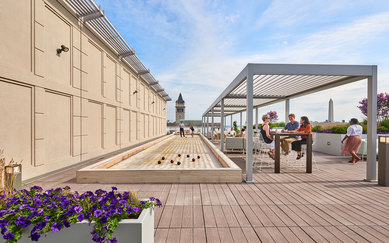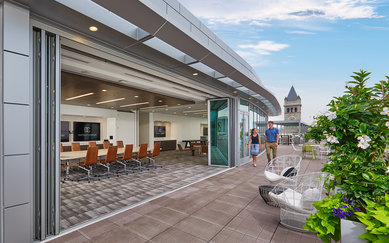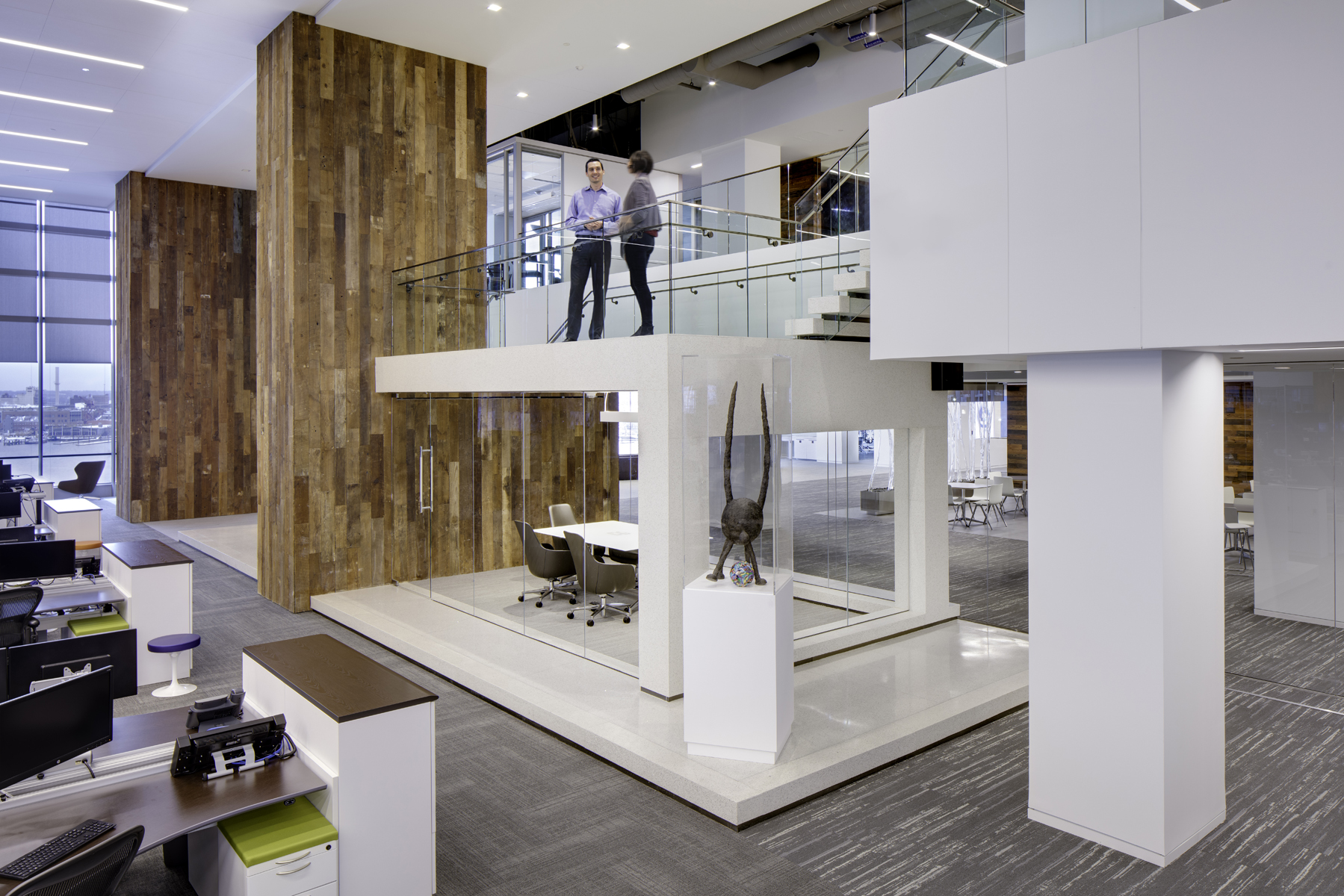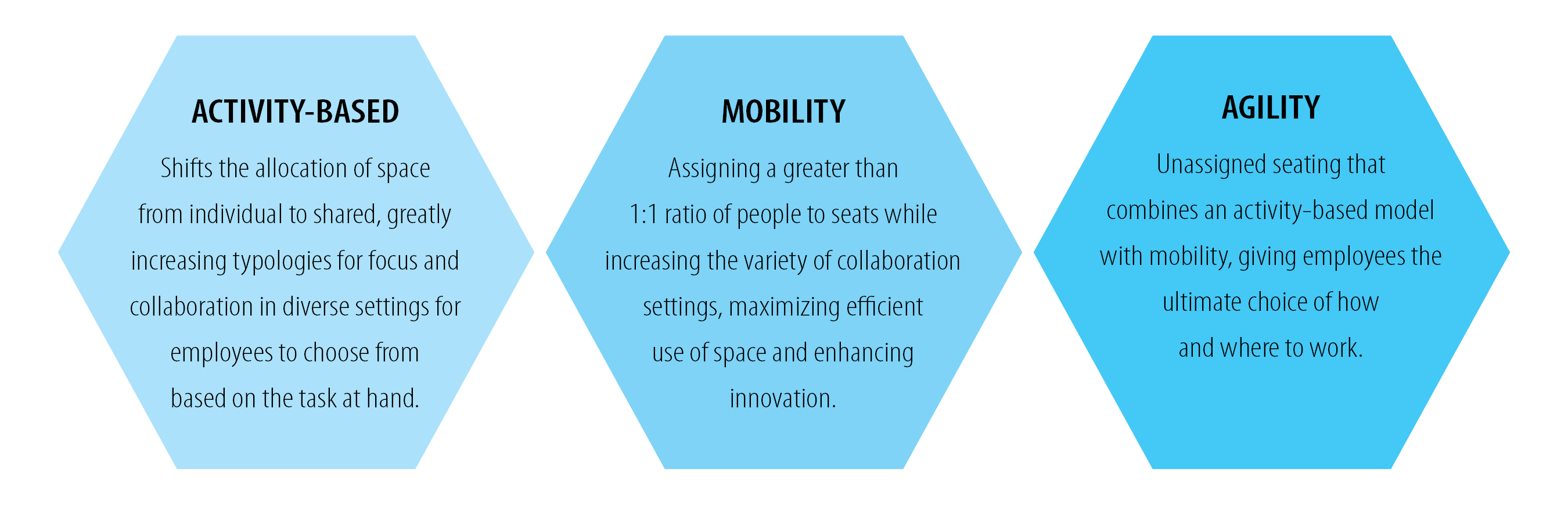Worlds Colliding: Bringing Your Whole Self To Work
As live, work and play environments evolve, so does the workplace.
This article, authored by Alexis Kim & John Crump of SmithGroup, was previously published in Work Design Magazine.
In a 1995 episode of Seinfeld, George Costanza quipped about “world’s colliding” and his fear that this collision would mean the end of “independent George”. The convergence George so stubbornly feared revolved around his distinct opinion that certain parts of his life – friendships, relationships, work, hobbies, etc. – should remain separate and he dreaded what would happen if the lines between them blurred. Now, over 20 years later, the lines that used to exist between live, work and play have not only blurred, but have almost entirely disappeared.
The convergence of live/work/play occur on various levels in today’s amenity-rich commercial office buildings and workplace interior projects. Key drivers of this evolution are due in part to rapid advancements in technology, coupled with shifting demographics in the workforce and impacts of the shared economy. Further complicated by the ubiquitous cell phone and the internet of things, our ties with work have dramatically changed in the most intimate of ways. Phrases and discussions around work-life balance have evolved into work-life integration. The modern-day worker acknowledges that with 24/hour access to all things work it is difficult, if not impossible, to separate the two completely. This work evolution has obstinately disrupted our personal lives. If work-life integration is the norm now, how do employees find the right balance and integrate their personal selves into their work? And how do companies promote that integration?
Since the mid-1990’s, large companies have been consolidating and reducing their real estate footprint for office workers – ushering in smaller cubicles, benching, work from home programs, etc. Decades later, the next wave of workplace solutions have arrived – activity-based settings, mobility and agility. Similar to the mid-90’s, the initial reason for implementing these approaches may have been based on real estate solutions and reducing overhead. However, if done correctly and focused on the company’s business goals, these strategies impart undeniable work, social, cultural, brand and lifestyle benefits for both the organization and their employees.
Companies of all sizes are integrating concepts such as activity-based work settings, mobility and agility. These approaches enhance collaboration, give more choice and variety to employees beyond cubicles and meeting rooms, and create community spaces within workplaces for social activities and networking. With a hospitality-driven design philosophy, these spaces typically mimic the home, coffee shop or hotel lobbies. By companies injecting such a variety inside the office, employees start to feel they are working outside the office in more intimate settings. The agile workplace strategy, for example, aims to provide the comfort and flexibility you would have in your own home. When working from home, one might start the day working at the dining room table after breakfast. Later, he/she might move to the couch perhaps to change posture or read a long report. The afternoon might be spent outside on the deck if it’s a nice day, taking conference calls. At the end of the day, the employee might end up back in the home-office to join a video conference. Agile workplace provides a variety of settings in a similar way, empowering the individual with autonomy to choose the most appropriate setting to complete each task.
Some companies take this approach a step further by incorporating internal food service programs, free snacks and amenities such as wellness, fitness, dry-cleaning/laundry service and daycare. By helping employees manage their personal lives better and acknowledging that employees have responsibilities outside of work, the organizations can attract and retain top talent. Taking cues from start-ups, policies such as bringing your pet to work, flexible work schedule/work from home policies have become the norm across industries. These programs help remove the stress from day-to-day tasks and companies bank on employees putting their focus back on their work. Whether intentional or not, these programs continue to blur where life ends, and work begins.
The relationship between companies and employees is also evolving. According to a ManpowerGroup survey of millennials in 2016, 50% are open to non-traditional forms (consulting, part time, multiple roles, etc.) of employment in the future and 75% would like to start or increase opportunities to work from home or remotely.
This significantly changes the role the workplace plays. Aside from offering choice within the office, flexibility and openness to embrace employee’s whole self is becoming even more paramount. Hackable environments where employees can rearrange workspace themselves to support their personal preferences or formation of ad-hoc teams are examples at a micro-level that provide a more permeable and living workplace environment.




In a recent conversation with a client from a baby boomer generation, he reflected how in the past, the work culture attitude was very much “keep your focus at work only on the job that needs to get done and keep personal lives separate”. As he thinks about the current and future states of work from his own organizational perspective, he noted it was imperative that the leaders learn about their employees at a personal level. Having authentic conversations and making meaningful connections will, in turn, create a culture that embraces and better supports diverse identities of all employees. This will allow their work experiences to be more seamless and integrated with that of their personal experiences.
At the recently completed Chamberlain Headquarters, an employee stated “The move has brought us closer together, fostered a greater sense of the one team spirit and has made an impact on the communities we serve.” As work and life continues to merge, people desire not only to align their identity with brand and culture, but also seek infusion of themselves through flexibility and permeability. A seamless live, work, play attitude in an environment where individuals feel valued allows people to be more authentic and ultimately be willing to share more of who they really are in the workplace. This fundamental shift develops stronger bonds between co-workers and leads to deeper, more meaningful dialogue on both personal and professional levels. As the ability to communicate more effectively with colleagues becomes engrained in the office culture, people are more open and share ideas without feeling vulnerable. It is this free and unfettered exchange of ideas that become the basis of collaboration and ultimately leads to the innovation companies desire to achieve.
As much as George Costanza feared his worlds colliding, he would enjoy and might even thrive in the modern workplace. Well, as long as he didn’t spend the day sleeping under his desk…

